Motorsports
Kyle Larson denies Chris Buescher the NASCAR Cup pole at Kansas
Last spring at Kansas, it was Kyle Larson versus Chris Buescher for the race win in the closest photo finish the Cup Series has ever seen. This weekend, it was the same two drivers again in the fight for pole, but it wasn’t quite as close. This is Larson’s 22nd career pole, but his first […]
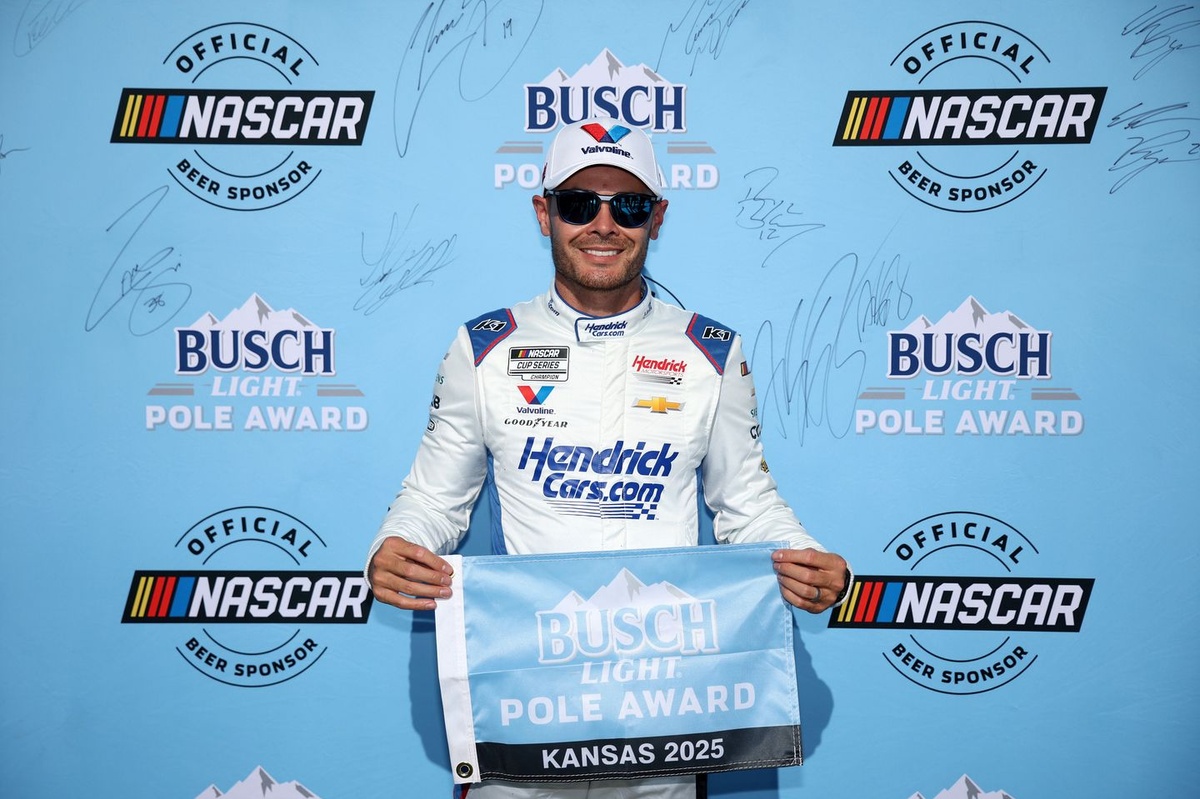
Last spring at Kansas, it was Kyle Larson versus Chris Buescher for the race win in the closest photo finish the Cup Series has ever seen. This weekend, it was the same two drivers again in the fight for pole, but it wasn’t quite as close. This is Larson’s 22nd career pole, but his first of the 2025 season and his first at Kansas as well.
“Pretty ironic to have us both on the front row here after our close finish a year ago,” smiled Larson. “It’s cool to finally get a pole here at Kansas too. I feel like I’ve been just short a number of times and I hope they still give out that pedal car (for pole) because that’s what I’ve always wanted. Especially with having some kids so I hope that’s still a thing. Just proud of our team … thanks to Chevy, the engine shop, everybody. So yeah, off to a good start.”
On his expectations for tomorrow, Larson said: ‘It seems like the pace is a lot faster throughout the run. Just in qualifying, we’re three-quarters of a second faster than we were here in the fall with similar track conditions and temps. So yeah, the tires and the cars and the setups have all gotten better. I think it’s going to be a fast-paced race, but I know our car is always good on mile-and-a-halfs. Just try to do a good job and execute on pit road and give ourselves late in the race like we did last year.”

Kyle Larson, Hendrick Motorsports Chevrolet
Photo by: Sean Gardner / Getty Images
Buescher had pole, until the very last driver rolled off pit road — with Larson then eclipsing him by 0.056s, lapping the 1.5-miler in 29.391 seconds. Buescher has just five front row starts in his entire Cup career, and none since Texas in September, 2023.
“We could have manufactured a better story if we tried, could we? That was a really awesome lap for this Ford Mustang,” said Buescher. “I’m proud of this group. Practice was really solid and Texas last week was awesome so we came into here with a lot of high hopes and it’s really showing up already. Missed it by that much, but we’re in a good spot and that will put us in clean air for the start of this race at a track we’ve been really good at.”
Behind the front row, Christopher Bell led the Toyotas in third, Tyler Reddick was fourth, and Joey Logano was fifth. Ty Gibbs, William Byron, Daniel Suarez, Chase Elliott, and Ryan Blaney filled out the remainder of the top ten.
Two drivers found the wall during the qualifying session, which proved costly. Josh Berry was the first to slide up into the wall, leaving him as the slowest of the 38 qualifiers. Kyle Busch got into fairly hard as well in Turns 3 and 4, qualifying 35th.
Some other notables starting deeper in the field: Denny Hamlin in 14th, Bubba Wallace 15th, Chase Briscoe 19th, Alex Bowman 21st, Ross Chastain 26th, and Brad Keselowski 36th.
Five drivers suffered tire failures due to low air pressures in practice, but this was not an issue that continued into qualifying.
Photos from Kansas – Practice & Qualifying
In this article
Be the first to know and subscribe for real-time news email updates on these topics
Motorsports
OPINION: The Bristol Blow-Up Was Good for Drag Racing
This past weekend in Bristol, Tennessee, we were reminded once again that drag racing isn’t just a technical sport – it’s an emotional one. Following Greg Anderson’s milestone win at the NHRA Thunder Valley Nationals, a bit of drama erupted between the KB Titan Racing camp and their longtime rivals at Elite Motorsports. Words were […]
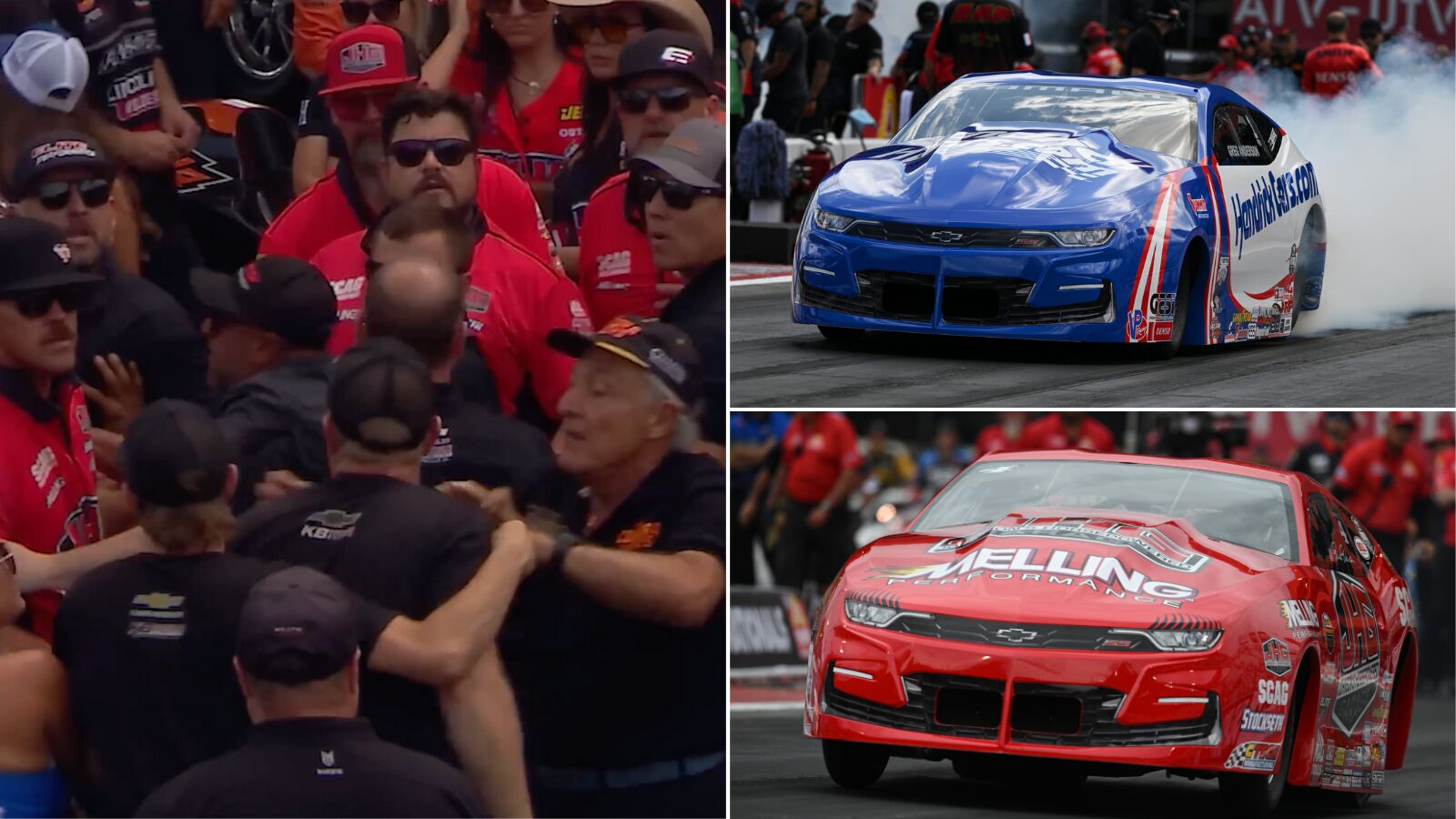
This past weekend in Bristol, Tennessee, we were reminded once again that drag racing isn’t just a technical sport – it’s an emotional one.
Following Greg Anderson’s milestone win at the NHRA Thunder Valley Nationals, a bit of drama erupted between the KB Titan Racing camp and their longtime rivals at Elite Motorsports. Words were exchanged. Tempers flared. A few racers and NHRA officials had to step in to keep it from escalating further.
Do we need to see fistfights on the starting line? Of course not. That’s not what I’m advocating for here.
But as a community, we’ve got to get off our high horse.
The knee-jerk reaction is to label this stuff as unsportsmanlike, or to worry about how it “looks” to fans or sponsors. But here’s the truth: we need more people in drag racing who care so deeply about what happens on that racetrack that it boils over from time to time.
I’ve said this for years – decades even: if you expect fans to care, then show them that you care. Passion is the price of admission in professional motorsports. If a driver can shrug off a loss or act like it doesn’t matter, why should anyone in the stands or at home watching on television or a livestream give a damn?
That blow-up in Bristol wasn’t a blemish. It was proof that the stakes are high again in Pro Stock.
Look, there’s been a noticeable shift over the last couple years. For a while, things got stale. The storylines were drying up. But then Greg Anderson and KB Titan Racing came storming back into the conversation over the course of the last couple years, and suddenly the top of the food chain was up for grabs again.
Elite Motorsports had been dominant for years, and rightfully so. But rivalries are born out of competition, not cooperation. Now, week in and week out, it’s a clash of titans – and that’s when things start to get interesting. That’s when tensions rise, when emotions peak, and when passion spills over. And honestly? That’s when fans start paying closer attention.
This isn’t unique to drag racing. Go back to the 1979 Daytona 500 – the race that put NASCAR on the map. Sure, Richard Petty won the thing, but what got the country talking was the infield brawl between Cale Yarborough and the Allison brothers. That moment, broadcast live on national TV during a snowstorm, made NASCAR.
Why? Because people saw raw, unfiltered emotion. They saw that it mattered.
Now, I’m not saying we should encourage fights. That’s not what this is about. What I am saying is that drag racing needs to stop pretending that emotion is a liability. It’s not. It’s an asset. It’s the foundation of every great story we’ve ever told in this sport. Every championship. Every comeback. Every upset.
Emotion is what connects the people in the grandstands to the people in the fire suits.
We’re in a time where fans crave authenticity more than polish. They don’t want canned interviews and sponsor-safe soundbites. They want the truth. They want to know that the men and women behind the wheel are human beings with skin in the game.
So when something like Bristol happens, I don’t cringe. I lean in. Because those moments, while maybe uncomfortable, are real. They’re proof that Pro Stock is alive and well – and that the people inside the ropes are racing with their hearts on fire.
Sportsmanship isn’t about being emotionless. It’s not about smiling while someone stomps your ass into the pavement. It’s about showing up, racing hard, and yes, sometimes letting your emotions out. The key is what happens next. Do you shake hands later? Do you come back and race just as hard next time? That’s sportsmanship.
Humans are going to human. That’s just how it works. We shouldn’t be surprised when competitors compete with emotion. We should expect it. Frankly, we should demand it.
So let’s stop acting like drama is always a bad thing. Let’s stop rushing to throw cold water on the fire every time it sparks up. Because in a sport built on the back of passion and intensity, a little heat between teams might just be exactly what we need to keep this thing burning bright.
This story was originally published on June 11, 2025. 

Motorsports
Droplight joins RLL as primary sponsor for Foster
Louis Foster’s No. 45 Rahal Letterman Lanigan Racing Honda will feature a new primary sponsor for this weekend’s Bommarito Automotive Group 500 and all of the races across the remaining events on the NTT IndyCar Series calendar. “We’re excited to welcome Droplight into the RLL family,” said Bobby Rahal, who co-owns RLL with David Letterman […]
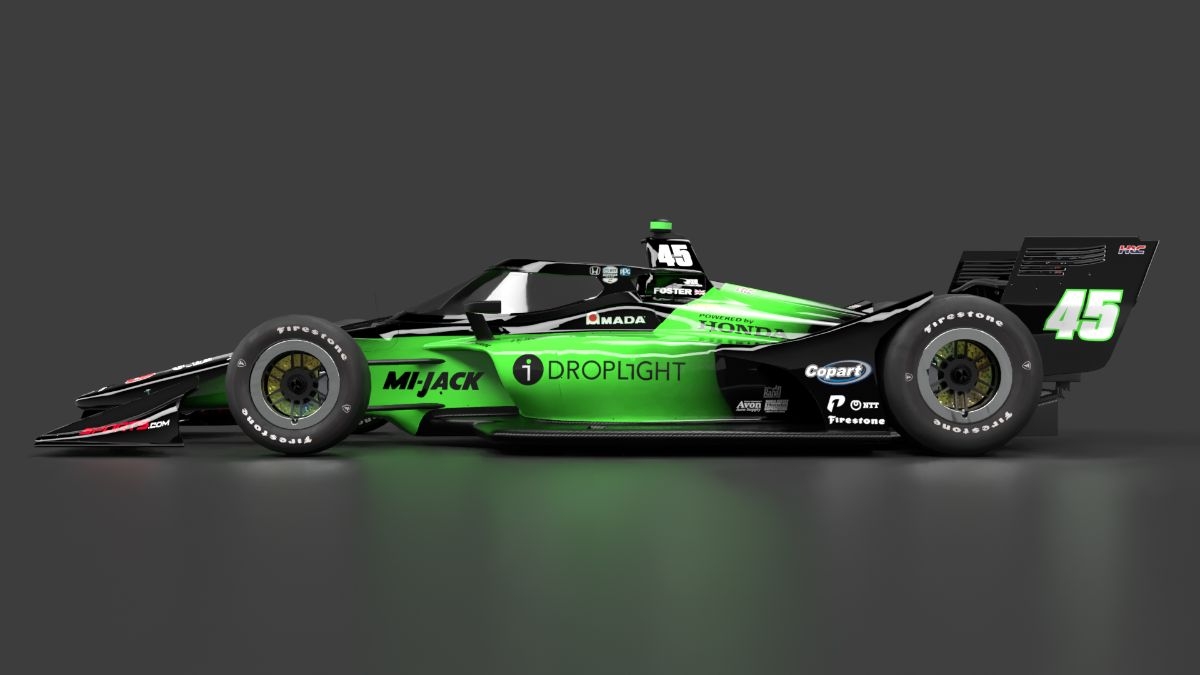
Louis Foster’s No. 45 Rahal Letterman Lanigan Racing Honda will feature a new primary sponsor for this weekend’s Bommarito Automotive Group 500 and all of the races across the remaining events on the NTT IndyCar Series calendar.
“We’re excited to welcome Droplight into the RLL family,” said Bobby Rahal, who co-owns RLL with David Letterman and Mike Lanigan. “Their team brings a rare combination of energy, vision, and execution that aligns perfectly with where we want to take this program. This isn’t just a sponsorship –it’s a platform for growth.”
According to RLL, “Droplight’s ecosystem includes investments and partnerships across entertainment, technology, media, and consumer brands. With this RLL partnership, the venture studio sees a unique opportunity to honor the legacy of motorsports excellence while helping shape its future.”
The strategic partnership runs through the end of the season
“The names Rahal, Letterman, and Lanigan stand for more than racing – they represent a legacy of discipline, vision, and leadership that has shaped generations of talent and performance,” said Droplight CEO Joseph Anderson. “We’re honored to support Louis Foster and the No. 45 team, and to play a role in building on that foundation. This is more than a partnership – it’s the next chapter in an ecosystem of innovation and impact.”
Motorsports
Formula 1’s $2B Sponsorship Boom Puts the NFL on Notice
Formula 1 is no longer just a seasonal spectacle; it has become a major player in the marketing world. In 2024, the sport, alongside its teams, generated $2.04 billion from sponsorship, just behind the NFL’s figure of roughly $2.5 billion, according to Autosport. That performance positions F1 ahead of numerous global sports properties like the NBA and […]
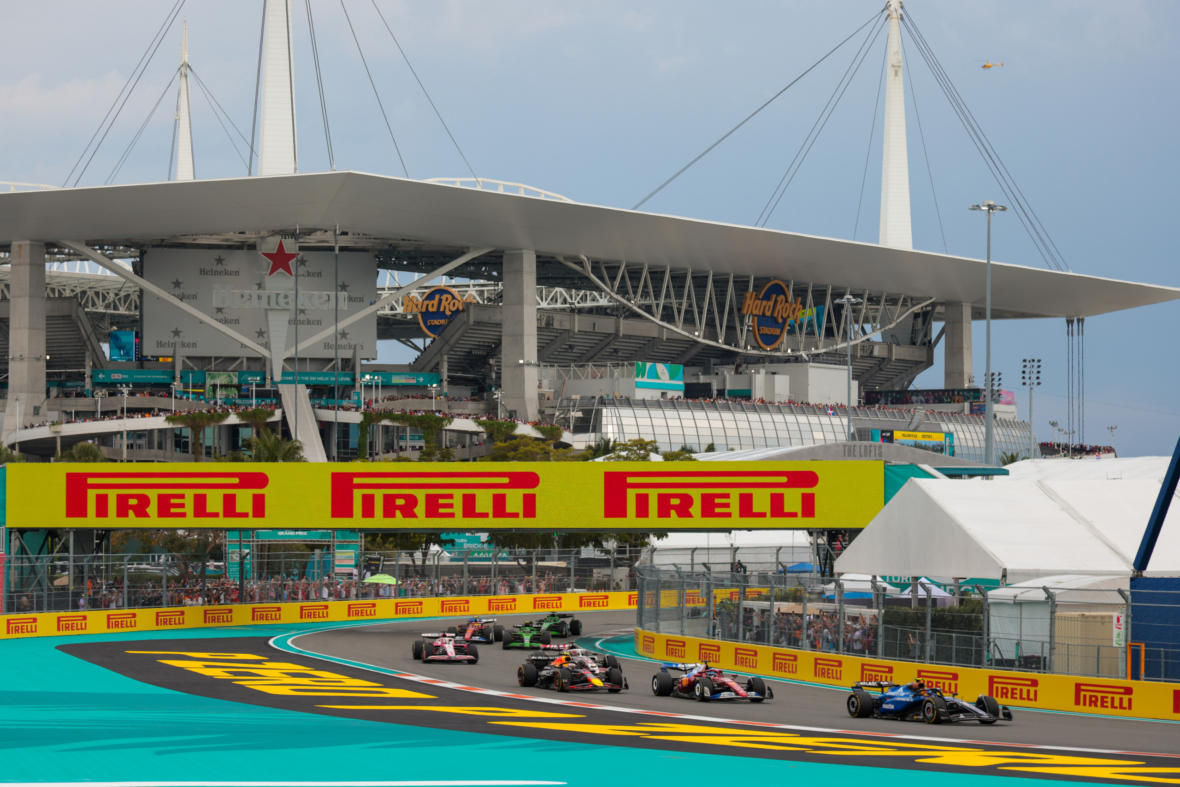
Formula 1 is no longer just a seasonal spectacle; it has become a major player in the marketing world. In 2024, the sport, alongside its teams, generated $2.04 billion from sponsorship, just behind the NFL’s figure of roughly $2.5 billion, according to Autosport.
That performance positions F1 ahead of numerous global sports properties like the NBA and MLB.
Distinct Sponsorship Strategy
Rather than signing many low-value agreements, F1 negotiates fewer, more lucrative deals. With 10 teams and 23 races, the sport averaged about $6 million per deal in 2024. By contrast, the NFL’s average sponsorship deal is in the neighborhood of $745,000.
These insights come from BlackBook Motorsport. That model highlights F1’s preference for depth over breadth, which appears to be working.
Premium Brand Partnerships
High-end and technology brands are eager to associate with F1. A prime example is the landmark 10-year, roughly $1 billion deal between Formula 1 and LVMH, covering its luxury portfolio including Louis Vuitton, TAG Heuer, and Moët & Chandon.
The Formula 1 announcement itself underlines the ambitions at play. That kind of alignment doesn’t just drive revenues, it elevates F1’s status as a lifestyle and innovation brand, not solely a racing sport.
A Younger, More Diverse Fanbase
A significant part of F1’s growth stems from its ability to attract younger fans. According to a recent Sports Stack report, the average F1 fan today is roughly 32 years old, a notable drop from 36 just five years ago.
This is further backed by FormulaRapida, which notes 42 percent of fans are under 35 and 41 percent are female. This trend aligns with F1’s conscious efforts around diversity and inclusion, factors that make the sport increasingly attractive to global brands.
The Streaming Effect
Netflix’s Drive to Survive changed the narrative. The series added depth and human drama, driving new viewer engagement, especially among younger audiences. Commentary in Motorsport suggests that the average age of viewers dropped from 44 to 32 following the show’s debut.
Additionally, FT’s reporting notes that U.S. viewership has roughly doubled since 2018, thanks to its growing presence and accessible storytelling. The show’s success offers lessons not just for F1 but for any sport looking to deepen storytelling and build emotional connections with fans.
Expanding Attendance and Engagement
F1’s global reach isn’t just about TV; it’s also about enthusiastic live audiences. The FormulaRapida stats report more than 6.5 million attendees over the season, with 17 sold-out events. Countries ranging from Australia to Mexico posted records of 300,000 to 480,000 attendees per weekend.
Combined with a 36 percent annual jump in social media followers and a strong WhatsApp and app user base, the sport has strengthened its relationship with fans offline and online.
What It Means for the NFL
The NFL remains the U.S. powerhouse in sports media, revenue, and franchise valuation. Still, Formula 1 is making rapid strides on the global stage. In 2024, its reach extended to 800 million fans across five continents, as noted by the Economic Times. If revenue equals reach, then F1 is increasingly punching what feels like above its weight.
The implication is clear: If the NFL wants to maintain dominance beyond U.S. borders, it should apply some of the strategies that have worked for F1. That includes investing in international storytelling, launching digital-first content that appeals to a youthful audience, and forging partnerships with global consumer brands seeking wide reach.
As audiences and data show, the world of sports marketing now demands a more interconnected, media-savvy approach.
Also Read: How To Stream Formula 1 Live Without Cable
Side-by-Side Comparison
| Metric | Formula 1 (2024) | NFL (2024) |
|---|---|---|
| Sponsorship Revenue | $2.04 billion | $2.5 billion |
| Average Deal Value | $6 million | ~$745,000 |
| Major Global Partner | LVMH 10-year deal | Pepsi 10-year deal |
| Average Fan Age | ~32 (FT analysis) | ~50 |
| Global Reach | 800M+ fans across 23 races | Primarily U.S.-based |
Motorsports
How far will NASCAR drivers go to prepare for Mexico’s high elevation?
In the final weeks of Alexa DeLeon Reddick’s pregnancy, husband Tyler Reddick slept in a tent. No, he wasn’t in trouble. He was in training. NASCAR’s first race outside the continental United States since 1958 presents drivers and teams with a unique challenge — Mexico City’s elevation. Advertisement Autódromo Hermanos Rodríguez, the 15-turn, 2.42-mile course […]
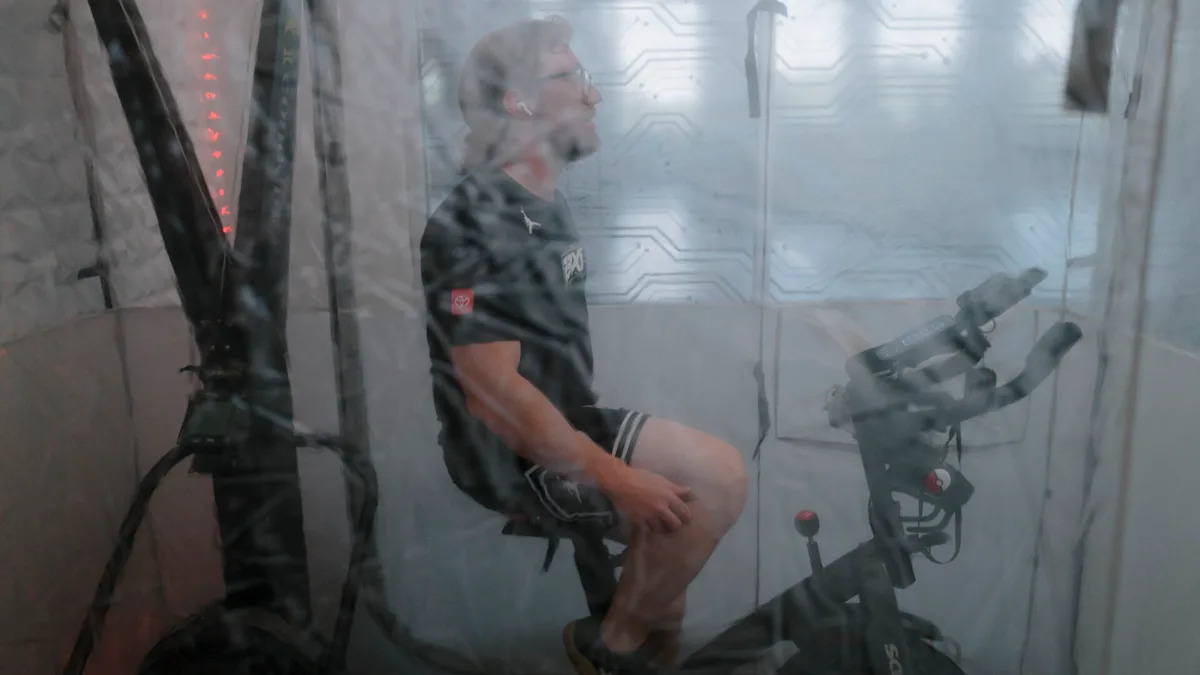
In the final weeks of Alexa DeLeon Reddick’s pregnancy, husband Tyler Reddick slept in a tent.
No, he wasn’t in trouble. He was in training.
NASCAR’s first race outside the continental United States since 1958 presents drivers and teams with a unique challenge — Mexico City’s elevation.
Advertisement
Autódromo Hermanos Rodríguez, the 15-turn, 2.42-mile course Xfinity and Cup drivers will compete on this weekend, sits at an elevation of nearly 7,500 feet. The next highest track on the Cup circuit in terms of elevation is Las Vegas Motor Speedway at about 2,000 feet above sea level.
With less oxygen at higher altitudes, driver performance could be impacted.
Drivers have tried different methods to prepare for the impact on their bodies from arriving in Mexico City earlier to acclimate, to wearing a mask that simulates less oxygen to sleeping in a hypoxic tent.
Reddick was among those who slept in a tent to adjust to the higher altitude and mitigate potential symptoms of altitude sickness.
Advertisement
“One side effect of it is my wife hasn’t been super happy about me sleeping in a hypoxic environment especially at the later stages of her pregnancy,” said Reddick, whose wife delivered the couple’s second child May 25.

NASCAR Cup Series All-Star – Practice Open and All-Star Entries
Mexico’s altitude will test engines for NASCAR Cup, Xfinity Series teams this weekend
Mexico’s Autódromo Hermanos Rodríguez is about 7,500 feet above sea level and the thinner air will impact engines.
While he said he noticed benefits from using the tent, will Reddick continue to use it as a part of his training after Mexico?
“My wife would throw a fit if I come home from Mexico and I’m like, ‘Yeah, we’re going to keep this tent thing going.’ She might put the tent outside,” Reddick said laughing.
Advertisement
The tent was part of the training program Toyota developed for its drivers after Christopher Bell raised questions before the season about what would be done to help maintain maximum performance in such trying conditions.
“We started that early in the season just talking and getting a plan together, making sure we’re prepared for it,” Bell said. “I’m proud of everyone at Toyota, the Toyota Performance Center. Caitlin Quinn has really headed up the department of physical fitness and made sure we’re ready for this challenge. Hopefully, the Toyota drivers are the ones that are succeeding.”
Quinn is the director of performance for the Toyota Performance Center in Mooresville, North Carolina. She was a strength coach at Florida State University before joining Toyota Performance Center.

NASCAR Cup Series Coca-Cola 600
Good news, bad news for NASCAR Cup teams ahead of Mexico City weekend
Advertisement
William Byron ranks first for the season in speed and restart rankings, according to Racing Insights.
The department has grown to include a sports dietician, physical therapist, physician assistant for orthopedic issues, mental health and wellness specialist, an additional strength coach and, as Quinn said, “just every science tool we can imagine.”
Quinn said all that is done “to help drivers find their edge in the car. The teams work really hard on making the cars as fast as possible and we’re trying to make the drivers able to perform at the best of their ability physically and mentally.”
After the conversation with Bell, Quinn began to work on a program to help drivers prepare for Mexico. That led to a couple of ways to help drivers adjust.
Advertisement
One was having drivers get used to a lower oxygen environment when they’re resting (the tent). Another was having them exercise in an environment where there was less oxygen. Toyota enclosed a space in its center with a bicycle inside it for drivers to ride in a lower oxygen setting.
Quinn said Toyota starting implementing those programs about eight weeks ago for drivers.
“I did a lot of exercising in the altitude tent,” said Bell, who will compete in both the Xfinity and Cup races in Mexico City. “Let’s see if it works.”
Reddick said sleeping in hypoxic tent proved beneficial, noting he felt he got better sleep in it.
“It is different sleeping in a hypoxic environment,” he said. “I’ve noted the changes so far, and I’m excited to see what it’s going to be like when I get there to Mexico City.”
Motorsports
How far will NASCAR drivers go to prepare for Mexico’s high elevation?
In the final weeks of Alexa DeLeon Reddick’s pregnancy, husband Tyler Reddick slept in a tent. No, he wasn’t in trouble. He was in training. NASCAR’s first race outside the continental United States since 1958 presents drivers and teams with a unique challenge — Mexico City’s elevation. Autódromo Hermanos Rodríguez, the 15-turn, 2.42-mile course Xfinity […]
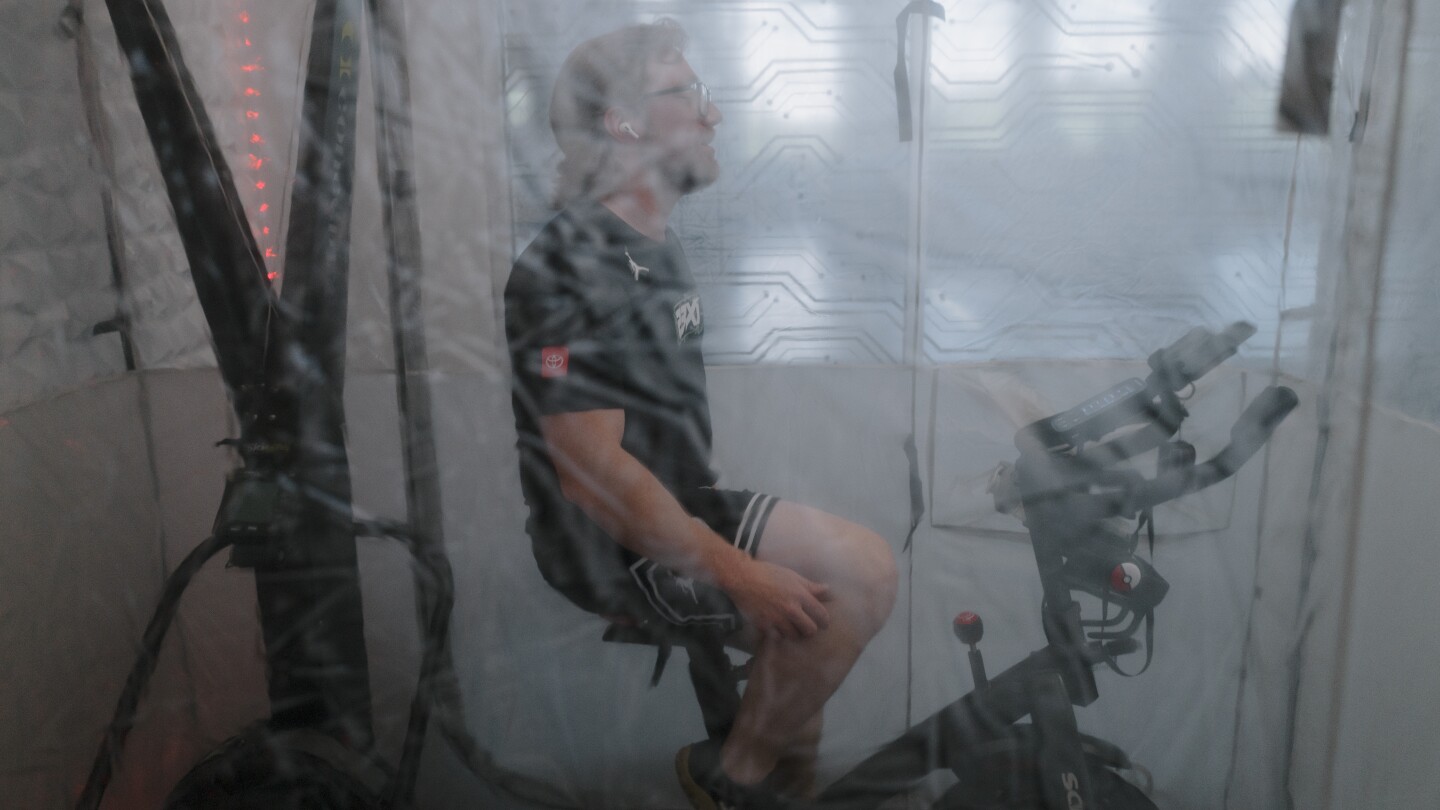
In the final weeks of Alexa DeLeon Reddick’s pregnancy, husband Tyler Reddick slept in a tent.
No, he wasn’t in trouble. He was in training.
NASCAR’s first race outside the continental United States since 1958 presents drivers and teams with a unique challenge — Mexico City’s elevation.
Autódromo Hermanos Rodríguez, the 15-turn, 2.42-mile course Xfinity and Cup drivers will compete on this weekend, sits at an elevation of nearly 7,500 feet. The next highest track on the Cup circuit in terms of elevation is Las Vegas Motor Speedway at about 2,000 feet above sea level.
With less oxygen at higher altitudes, driver performance could be impacted.
Drivers have tried different methods to prepare for the impact on their bodies from arriving in Mexico City earlier to acclimate, to wearing a mask that simulates less oxygen to sleeping in a hypoxic tent.
Reddick was among those who slept in a tent to adjust to the higher altitude and mitigate potential symptoms of altitude sickness.
“One side effect of it is my wife hasn’t been super happy about me sleeping in a hypoxic environment especially at the later stages of her pregnancy,” said Reddick, whose wife delivered the couple’s second child May 25.

Mexico’s Autódromo Hermanos Rodríguez is about 7,500 feet above sea level and the thinner air will impact engines.
While he said he noticed benefits from using the tent, will Reddick continue to use it as a part of his training after Mexico?
“My wife would throw a fit if I come home from Mexico and I’m like, ‘Yeah, we’re going to keep this tent thing going.’ She might put the tent outside,” Reddick said laughing.
The tent was part of the training program Toyota developed for its drivers after Christopher Bell raised questions before the season about what would be done to help maintain maximum performance in such trying conditions.
“We started that early in the season just talking and getting a plan together, making sure we’re prepared for it,” Bell said. “I’m proud of everyone at Toyota, the Toyota Performance Center. Caitlin Quinn has really headed up the department of physical fitness and made sure we’re ready for this challenge. Hopefully, the Toyota drivers are the ones that are succeeding.”
Quinn is the director of performance for the Toyota Performance Center in Mooresville, North Carolina. She was a strength coach at Florida State University before joining Toyota Performance Center.

William Byron ranks first for the season in speed and restart rankings, according to Racing Insights.
The department has grown to include a sports dietician, physical therapist, physician assistant for orthopedic issues, mental health and wellness specialist, an additional strength coach and, as Quinn said, “just every science tool we can imagine.”
Quinn said all that is done “to help drivers find their edge in the car. The teams work really hard on making the cars as fast as possible and we’re trying to make the drivers able to perform at the best of their ability physically and mentally.”
After the conversation with Bell, Quinn began to work on a program to help drivers prepare for Mexico. That led to a couple of ways to help drivers adjust.
One was having drivers get used to a lower oxygen environment when they’re resting (the tent). Another was having them exercise in an environment where there was less oxygen. Toyota enclosed a space in its center with a bicycle inside it for drivers to ride in a lower oxygen setting.
Quinn said Toyota starting implementing those programs about eight weeks ago for drivers.
“I did a lot of exercising in the altitude tent,” said Bell, who will compete in both the Xfinity and Cup races in Mexico City. “Let’s see if it works.”
Reddick said sleeping in hypoxic tent proved beneficial, noting he felt he got better sleep in it.
“It is different sleeping in a hypoxic environment,” he said. “I’ve noted the changes so far, and I’m excited to see what it’s going to be like when I get there to Mexico City.”
Motorsports
Chicago Street Race adds Arby’s as major sponsor
NASCAR is beefing up its sponsorship of next month’s Chicago Street Race with the addition of Arby’s. The fast food chain was announced as a “founding partner” Wednesday of the third annual race around the pop-up Grant Park course during the Fourth of July weekend. Arby’s joins Blue Cross and Blue Shield of Illinois and […]

NASCAR is beefing up its sponsorship of next month’s Chicago Street Race with the addition of Arby’s.
The fast food chain was announced as a “founding partner” Wednesday of the third annual race around the pop-up Grant Park course during the Fourth of July weekend. Arby’s joins Blue Cross and Blue Shield of Illinois and Xfinity as major sponsors of the event.
“This marks an exciting moment for our brand in the world of motorsports, with one of the most dynamic and groundbreaking events in racing,” Jeff Baker, chief marketing officer at Arby’s, said in a news release. “Nothing goes better with NASCAR than one of our delicious Arby’s sandwiches, and we can’t wait to bring the meats to the streets for race fans and Arby’s fans in Chicago and beyond.”
Arby’s, which is new to NASCAR, is replacing Chicago-based McDonald’s as a major sponsor of the street race.
In addition to race weekend visibility and promotions, Arby’s is offering chances through June 22 to win tickets to the Chicago Street Race at 47 restaurants in the city and suburbs. The unique event on the NASCAR calendar features an Xfinity Series race on July 5, and the nationally televised Grant Park 165 Cup Series race on July 6.
The announcement comes as NASCAR and the city are gearing up for a more streamlined race weekend event with a smaller concert lineup, downsized hospitality buildout, reduced ticket prices and an accelerated setup/breakdown schedule.
Southern rockers the Zac Brown Band, scheduled to perform after the Xfinity Series race, are the only musical headliners on the bill for year three. But NASCAR is planning to add a miniature golf course and other family-friendly activities to the festivities.
The Grant Park 165 on Sunday is scheduled to start at 1 p.m., 2½ hours earlier than last year, in the hopes of finally finishing the race, which was shortened by inclement weather the first two years. The Cup Series broadcast is also moving from NBC to cable channel TNT.
Tickets, which went on sale in January, are less expensive this year. Single-day general admission passes start at $99 — a third less than last year — while premium grandstand reserved seats are priced at a nearly 50% reduction. Children 12 and under are free both days, with an accompanying adult.
The Chicago Street Race will once again feature a 12-turn, 2.2-mile course through Grant Park, down DuSable Lake Shore Drive and up Michigan Avenue, which will be closed off and lined with fences, grandstands and hospitality suites. But a relocated concert stage will replace the Skyline, a mammoth temporary structure along Columbus Drive that last year housed the most expensive suites overlooking the start/finish line at Buckingham Fountain.
Street closings for the buildout have been reduced to 18 days. The first shutdown is set for June 19, with all streets to be reopened by July 14.
Chicago saw a boost in tourism last year. Will the pope be a blessing in 2025?
NASCAR is in the third and final year of an inaugural agreement with the city to host the Chicago Street Race, a deal struck during Mayor Lori Lightfoot’s administration.
Last year, the race generated $128 million in total economic impact and drew 53,036 unique visitors, according to a study commissioned by Choose Chicago, the city’s tourism arm.
rchannick@chicagotribune.com
Originally Published:
-

 Health6 days ago
Health6 days agoOregon track star wages legal battle against trans athlete policy after medal ceremony protest
-

 NIL2 weeks ago
NIL2 weeks ago2025 NCAA Softball Tournament Bracket: Women’s College World Series bracket, schedule set
-

 Professional Sports6 days ago
Professional Sports6 days ago'I asked Anderson privately'… UFC legend retells secret sparring session between Jon Jones …
-

 College Sports2 weeks ago
College Sports2 weeks agoIU basketball recruiting
-

 Professional Sports6 days ago
Professional Sports6 days agoUFC 316 star storms out of Media Day when asked about bitter feud with Rampage Jackson
-

 Rec Sports2 weeks ago
Rec Sports2 weeks agoScott Barker named to lead CCS basketball • SSentinel.com
-

 Youtube3 weeks ago
Youtube3 weeks agoAnt greets A-Rod & Barry Bonds before Game 3
-

 Rec Sports2 weeks ago
Rec Sports2 weeks agoJ.W. Craft: Investing in Community Through Sports
-

 College Sports2 weeks ago
College Sports2 weeks agoOlympic gymnastics champion Mary Lou Retton facing DUI charge
-

 Youtube3 weeks ago
Youtube3 weeks agoLogo LeBron




































